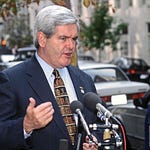
Today, conservative critics condemn the so-called “liberal media” for being in cahoots with policymakers and politicians—but there was a time when that was a formal, accepted way of doing business. In her new book, City of Newsmen: Public Lies and Professional Secrets in Cold War Washington (University of Chicago Press, 2022), University of Wisconsin historian Kathryn J. McGarr takes us into that world—one in which journalists agreed, as McGarr explains in today’s episode, to publish government lies—but not lie for the government; to work to prevent World War III by serving as informal advisors to the powerful, and in return, filtering news to keep the United States safe from nuclear holocaust.
Program notes:
The clip of James Reston discussing Eisenhower and the U-2 overflight is originally from C-Span’s American History TV, June 2, 1995. You can see the whole interview here and learn more about Reston here.
For a lively history of the New York Times that inadvertently highlights its culture of white masculinity, see Gay Talese, The Kingdom and the Power: Behind the Scenes at The New York Times: The Institution That Influences the World (Random House, 1966).
Last week, the errant Chinese weather balloon that entered United States airspace sparked an account of the U-2 incident in the New York Times. Francis Gary Powers’ account of the U-2 incident is in Operation Overflight: A Memoir of the U-2 Incident (Potomac Books, 2003).
What are the advantages and pitfalls for journalists to learn things “on background?” You can learn more from Tom Jones at the Poynter Institute (November 11, 2021).
What did liberal internationalism mean after World War II? You might want to dig into Elizabeth Spaulding’s The First Cold Warrior: Harry Truman, Containment, and the Remaking of Liberal Internationalism (University of Kentucky Press, 2006).
To learn more about how female and Black journalists experienced gender and racial segregation in political journalism, take a look at Nan Robertson, The Girls in the Balcony: Women, Men, and the New York (Random House, 1992), and Wallace Terry, Missing Pages: Black Journalists of Modern America: An Oral History (Basic Books, 2007). Terry’s book includes an interview with Ethel Payne, who Kathryn discusses.
Kathyrn also mentions Walter Lipmann, a towering figure in journalism of the period. If you are interested in Lipmann’s views, you can read his Public Opinion: How People Decide; The Role of News, Propaganda and Manufactured Consent in Modern Democracy and Political Elections (1922).
Claire and Kathryn discuss the Cuban Missile Crisis, a tense standoff between the United States and the Soviet Union in October 1962. There is a new international account of this nuclear confrontation by Serhii Plokhy, Nuclear Folly: A History of the Cuban Missile Crisis (W.W. Norton, 2022).
You can download this podcast here or subscribe for free on Apple iTunes, Spotify, Google Podcasts, or Soundcloud. Do you use another service? Let me know in the comments, and I will submit it to them!














Share this post